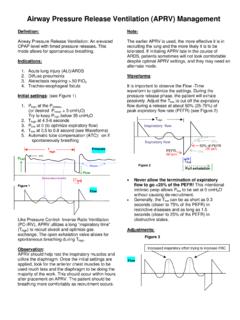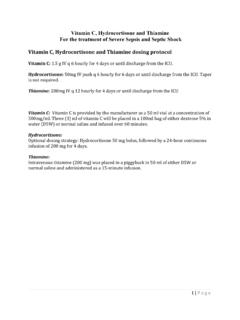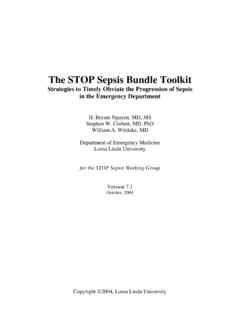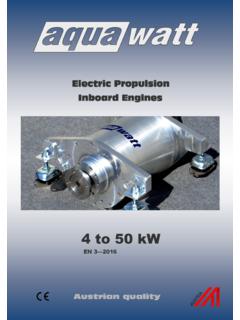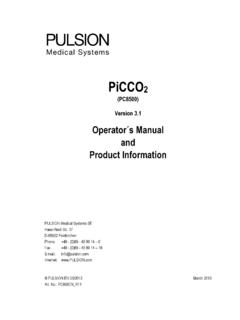Transcription of Argatroban for anticoagulation in continuous renal ...
1 Argatroban for anticoagulation in continuous renalreplacement therapy*Andreas Link, MD; Matthias Girndt, MD; Simina Selejan, MD; Alexander Mathes, MD; Michael Bo hm, MD;Hauke Rensing, MDContinuous renal replacementtherapy (CRRT) is proven ef-fective for critically ill pa-tientswith (acute) renal fail-ure (1, 2). In patients with heparin-induced thrombocytopenia type II(HIT-II) requiring CRRT effective anti-coagulation, it is necessary to avoidthrombembolic complications (3, 4).The options for anticoagulant treat-ment in critically ill patients withHIT-II requiring CRRT are limited andinclude danaparoid and direct danaparoid hasbeen used in HIT-II for a long time sev-eral major drawbacks have been with heparin/platelet fac-tor 4 antibodies in 15% of cases (5), pro-longation of half-life in renal failure up to36 48 hours (6), and an increased riskfor bleeding events in 46% (7) have beendescribed.
2 Direct thrombin inhibitors, in-cluding Argatroban and lepirudin, differin their mode of elimination. The majorroute of elimination of lepirudin is renalclearance. In anuria prolonged half-livesup to 50 hrs have been reported (8). Fur-thermore, after 5 days 44% of the pa-tients developed lepirudin antibodies thatdecrease renal clearance, increase activ-ity, and thus, augment the risk of bleed-ing (9) contributing to major bleedingcomplications (10, 11).In contrast, Argatroban is mainly elim-inated by hepatic metabolism. As such, Argatroban may be the more appropriatedirect thrombin inhibitor in critically illpatients with renal impairment and withthe necessity for CRRT. Prospective dataon Argatroban under hemodialysis in-clude case reports and small studies onlyin patients on intermittent hemodialysis(12 14) or in patients after cardiovascu-lar surgery with cardiopulmonary by-passes (15).
3 In our study, critically ill patients withHIT-II-syndromes or histories of HIT-IIand necessity for CRRT were assigned toan Argatroban treatment. The investiga-tion focused on predictors for the main-tenance doses of Argatroban with efficacyand safety of Argatroban being and RegistrationWith approval of the Institutional ReviewBoard, we evaluated all critically ill patientswith necessity for CRRT and clinical signs orhistory of HIT-II syndromes on the medicaland surgical intensive care units of the Uni-versity Hospital of the Saarland from January2006 to June 2007. HIT-II was defined clini-cally as an unexplained decrease of more than50% in platelet count from the patients base-*See also p.
4 The Klinik fu r Innere Medizin III (AL, SS, MB,);Klinik fu r Innere Medizin IV (MG); Klinik fu r Ana sthesi-ologie und Intensivmedizin (AM, HR), Universita tsklini-kum des Saarlandes; D-66421 Homburg/Saar, authors have not disclosed any potential con-flicts of information regarding this article, 2008 by the Society of Critical CareMedicine and Lippincott Williams & WilkinsDOI: : Argatroban , a direct thrombin inhibitor, was evalu-ated for anticoagulation in continuous renal replacement therapy(CRRT) in critically ill patients with heparin-induced thrombocy-topenia type II and acute renal failure. The investigation focusedon predictors for the maintenance doses of Argatroban withefficacy and safety of Argatroban being secondary :Prospective, dose finding :Two intensive care units (medical and surgical) of auniversity :Medical and surgical patients (n 30) with acute orhistories of heparin-induced thrombocytopenia type II and acuterenal failure with necessity for :CRRT with Argatroban for and Main Results:Critical illness severityscores Acute Physiology and Chronic Health Evaluation (APACHE)-II, Simplified Acute Physiology Score (SAPS) II, and the indocya-nine green plasma disappearance rate (ICG-PDR) were correlatedto the Argatroban maintenance doses.
5 These diagnostic tools canhelp to identify patients with the necessity for decreased argatro-ban doses. The following recommendations for Argatroban dosingduring CRRT could be determined: a loading dose of 100 g/kgfollowed by a maintenance infusion rate ( g/kg/min), whichcan be calculated from the scores as follows: for APACHE II: APACHE II (r .81,p< ); for SAPS II: SAPS II (r .8,p< ); and for ICG-PDR: ICG-PDR (r .89,p< ). The efficacy and safety of anticoag-ulation during CRRT were determined by the steady state of bloodurea nitrogen ( mg/dL), mean filter patency at 24 hrs(98%), and the rate of bleeding episodes. Only two patients devel-oped minor bleeding; no patient developed severe bleeding :In critically ill patients with heparin-inducedthrombocytopenia type II and necessity for CRRT critical illnessscores (APACHE II, SAPS II) or ICG-PDR can help to predict therequired Argatroban maintenance dose for anticoagulation .
6 Thesepredictors identify decreased Argatroban dosing requirementsresulting in effective and safe CRRT. (Crit Care Med 2009; 37:105 110)KEYWORDS: continuous renal replacement therapy; heparin-induced thrombocytopenia II syndrome; Argatroban ; multipleorgan failure105 Crit Care Med 2009 Vol. 37, No. 1line, or a platelet count lower than 100 109/L while on heparin therapy, or by positivelocal laboratory tests. HIT-II screening testswere performed at the University HospitalLaboratory using the particle gel immunoas-say (ID-HPF-4, DiaMed, Switzerland) for rapiddetection and the enzyme-linked immunosor-bent assay for discovering antibodies (IgG,IgA, IgM) to heparin-platelet factor 4 com-plexes.
7 Both HIT-II tests were done for allpatients. Critical illness was defined by com-monly used scores in intensive care medicine:Acute Physiology and Chronic Health Evalua-tion II (APACHE-II, 16) and Simplified AcutePhysiology Score II (SAPS-II, 17). Thus, crit-ical illness and multiple organ dysfunctionsyndromes were defined as a minimumSAPS-II score of 30 and Exclusion CriteriaCritically ill patients with manifestation orhistory of HIT-II and necessity for CRRT weretreated with Argatroban after exclusion of clin-ically relevant bleeding signs, transientthrombocytopenia, disseminated intravasalcoagulopathy, and preexisting chronic hepaticdysfunction (Child-Pugh C). Concomitanttreatment was performed according to bestmedical practice.
8 The decision to anticoagu-late with Argatroban was made by the physi-cian in charge according to clinical needs andthe inclusion and exclusion renal ReplacementTherapyContinuous venovenous hemodialysis wasperformed with a polysulfone high-flux hemo-dialyzer using a roller-pump-driven hemofil-tration device manufactured by Fresenius AG(ADM 08; Bad Homburg, Germany) with abicarbonate dialysate at a flow rate of 2000mL/hr. The blood flow was 100 mL/min. Theultrafiltration rate depended on clinical re-quirements (0 200 mL/hr). The hemodialysistubes and filters were renewed every 24 PharmacokineticsArgatroban (molecular weight dal-tone) is a rapidly acting direct thrombin in-hibitor with moderate protein binding (54%),primarily to albumin (20%) and 1-acid gly-coprotein (34%).
9 Its short elimation half-lifeof 35 51 mins and major route of hepaticmetabolism (70%) are important aspects foruse of Argatroban in patients with renal fail-ure; 14% of the unchanged drug is elimi-nated via feces and 16% is eliminated hemodialysis, the dialytic clearance ofargatroban was mL/min/kg, suggest-ing an increase of 20% in Argatroban clear-ance (15).Management and Monitoring ofAnticoagulationAt the beginning of CRRT, all patients re-ceived Argatroban at a dose of 100 g/kg as abolus injection followed by a continuous infu-sion of 1 g/kg/min. Argatroban was appliedinto the extracorporeal circulation (prefilterinjection/infusion). The monitoring of antico-agulation was performed by repetitive mea-surements of the systemic activated partialthromboplastin time (aPTT) according tostandard methods.
10 The anticoagulation regi-men was designed to result in a to 3-foldelevation of aPTT. The first measurement ofaPTT was done 30 minutes after startingCRRT, followed by further controls every 60minutes until a to 3-fold elevated aPTTwas reached. If aPTT was below the therapeu-tic range, the Argatroban dose was increasedstepwise (in steps of g/kg/min). If aPTTwas more than 3-fold elevated, Argatroban wasdiscontinued for 2 consecutive hours and step-wise reduced ( g/kg/min). When the he-mofilter systems were routinely changed, theargatroban infusion was continued and no fur-ther boluses were given. In all surgical cases,CRRT with Argatroban started 24 48 hrs afterthe surgical for anticoagulation ,Efficacy, and Argatroban dose ti-tration, plasma aPTT was measured before, 30minutes after starting CRRT, and every houruntil a to 3-fold aPTT was reached.
